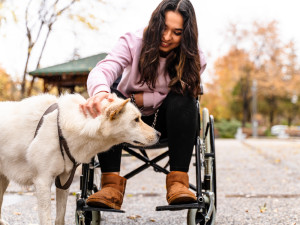How to Register an Emotional Support Animal
Confused about ESA rules? Here’s a comprehensive guide that explains everything you need to know about emotional support animals registration.

share article
As anyone who has lived with dogs knows, they can provide incredible solace for people when they’re struggling. After these past few years, mental health concerns abound, and we definitely need the help of our favorite furry pals. For some, that comfort goes beyond being a soft shoulder to cry onopens in a new tab; people struggling with their mental health can have their dog registeredopens in a new tab as an emotional support animalopens in a new tab (ESA).
Unlike regular service-dog registration, ESAs don’t have to go through puppy service-dog training to get emotional support animals registration. They don’t even have to be a dog. But be careful: Although there are a lot of websites out there that claim to be able to register your service dog online or provide a license, for your dog to get a legitimate emotional support animal registration, you will have to get a letter from a certified mental health professional. Below, what you need to know about ESA registration.
What is an ESA, exactly?
An ESAopens in a new tab is an animal who provides therapeutic benefits — such as companionship, comfort, and supportopens in a new tab — to a person struggling with mental illness. ESAs aren’t limited to dogs and catsopens in a new tab; any domesticated animal can be an ESA, as long as a mental health professional determines that their presence helps their owner emotionally. ESAs can help individuals with depression, anxiety, PTSD, learning disorders, and certain phobias.
Although people online have cracked jokes about people’s emotional support pigsopens in a new tab and turkeysopens in a new tab on flightsopens in a new tab, there are legitimate reasons why someone would need an emotional support animal that is not a dog or a cat. For example: Rats are considered excellent emotional support animals because they are highly intelligent, extremely social, and easier to care for than a dog or a cat. They make great companions for those who might have limited energy or mobility.
How do I register my dog as an ESA?
First, keep in mind that there is no official U.S. government registry of service dogs, nor is there any official emotional support animal certification process. More often than not, websites that let you buy “official service dog registrations” are scams. That being said, you can show that your animal is a legitimate ESA by obtaining a letter from a certified mental health professionalopens in a new tab.
Step 1: Speak with a certified mental health professional
The first step to ESA registration is speaking with a certified mental health professional. If you don’t already have a certified mental health professional who you are in contact with, you can search for one online or ask your primary doctor for a referral. Many directories, such as the one provided by Psychology Todayopens in a new tab, allow you to search for a mental health professional by zipcode. Not all telehealth medical professionals will provide an ESA letter — for example, Better Helpopens in a new tab will not — but it is possible to get an ESA letter from a telehealth professional.
Step 2: Together, determine the need for an ESA
Mental health professionals will require a mental health diagnosis opens in a new tabbefore they will provide you with a letter for ESA registration. For an ESA to be protected under the Fair Housing Amendments Act of 1988, the pet parent must be classified as disabled; the U.S. Department of Housing and Urban Development (HUD) says “a disabled person is any person who has a physical or mental impairment that substantially limits one or more major life activities and has a record of such impairment.” After diagnosis, you and your doctor can discuss what an ESA would look like for you and decide together if ESA registration is the best path forward.
Step 3: Obtain a letter on official letterhead
If a mental health professional has agreed you are a good fit for ESA registration and you’ve thought out the responsibilities and benefits of registering for an emotional support animal, you can ask your mental health professional for an ESA letter on official letterhead. The letter must include opens in a new tabyour mental health professional’s licensing and contact information, their practice address, the day’s date and provider’s signature, and details about your personal diagnosis and type of animal.
How does an animal provide emotional support?
According to the National Institute of Healthopens in a new tab (NIH), interacting with pets can decrease one’s levels of the stress hormone cortisol and help lower blood pressure. Studies have found that having pets can also “reduce loneliness, increase feelings of social support, and boost your mood.” As Dr. Layla Esposito, who oversees the NIH’s Human-Animal Interaction Research Program explains, which animal can best support you depends on your specific needs.
“Is your goal to increase physical activity? Then you might benefit from owning a dog,” Dr. Esposito advises. “You have to walk a dog several times a day, and you’re going to increase physical activity. If your goal is reducing stress, sometimes watching fish swim can result in a feeling of calmness. So there’s no one-type-fits-all.”
How is an ESA different from a service animal?
What differentiates an ESA from a service animal is that ESAs are not trained to perform specific tasks for their ownersopens in a new tab. To qualify as a service animal under the Americans with Disabilities Actopens in a new tab (ADA), your animal (1) must be a dog (or in very specific cases, a miniature horse), and (2) must be “individually trained to do work or perform tasks for people with disabilities.” While ESAs offer general emotional support to their parents just by being with them, service dogs receive extensive and individualized training so they can help support individuals with a number of physical and mental disabilities. These include seeing and hearing impairments, epilepsy, diabetes, PTSD, autism, and those in need of mobility assistance.
How do you train an ESA?
Emotional support animals have much lower training requirements than Psychiatric Service Dogs (PSDs). PSDs are trained to perform specific services, such as reminding their pet parent to take medication, waking and distracting their pet parents during night terrors, or placing pressure on a pet parent’s chest to encourage emotional regulation during a panic attack. PSDs can be legally brought into any public establishment (including public transit), so PSDs require more extensive training and socialization; if they lungeopens in a new tab, barkopens in a new tab, or biteopens in a new tab, they can legally be asked to leave.
Though emotional support animals are not required by law to be trained the way service animals are, training an ESA is a massive benefit to both you and your pet. Training isn’t only about getting your animal to behave a certain way; it is also an amazing way to bond with your petopens in a new tab, and it’s necessary for keeping an animal mentally stimulated and physically healthy. Plus, it’s lots of fun. There are some basic pieces of trainingopens in a new tab that all pets should know, such as litteropens in a new tab or potty trainingopens in a new tab, “leave itopens in a new tab,” and (for all dogs and some catsopens in a new tab) leash trainingopens in a new tab. But for peak fun and bonding, you should go beyond the basicsopens in a new tab and train for tricks like hide-and-seekopens in a new tab and fetchopens in a new tab (it’s not just for dogsopens in a new tab!).
What rights do ESAs have?
Because ESAs do not qualify as service animals under the ADA, they don’t have all the same rights. While service animals must be allowed in all businesses and spaces where the public generally is allowed to go, ESAs don’t have that same access. And while passengers were previously allowed to bring their ESAs with them on planes, in December 2020, the Department of Transportation announced that it was revising the Air Carrier Access Actopens in a new tab to only include service animals that have been trained to perform a specific task for their owner. This meant no more high-flying ESAs. Instead, you can register your dog as a PSD, and they can fly with you.
Although there are some barriers for ESAs, they do have some protections. Under the Fair Housing Actopens in a new tab (FHA), landlords may not refuse housingopens in a new tab to those with disabilities or who require an ESA, even if the building has a no-pets policy. They are, however, allowed to ask for documentation or a letteropens in a new tab from a mental health professional that confirms a tenant’s need for an ESA. Read hereopens in a new tab for more information on what people can and can’t ask you about your ESA.
Emotional Support Animals Registration FAQ
How do I register an emotional support animal in the US?
There is no official emotional support animal certification process. You can show that your animal is a legitimate ESA by obtaining a letter from a certified mental health professional.
Does anxiety qualify for an emotional support animal?
Anxiety is a common reasonopens in a new tab for registering an emotional support animal. An animal can be registered as an ESA as long as a mental health professional determines that their presence helps their owner emotionallyopens in a new tab. ESAs can help individuals with depression, anxiety, PTSD, learning disorders, and certain phobias.
Is there an official registry for emotional support animals?
There is no official U.S. government registry of service animals.
How do I know if my ESA is legit?
It’s extremely important to get legitimate emotional support animal registration. As long as you see a licensed mental health professional (LMHP) and your ESA letter is written on your provider’s official letterhead and includes their license number and practice address, your ESA letter is legitimate.
Are there any fees associated with registering an emotional support animal?
According to the Fair Housing Act, a landlord can’t request additional fees for an ESA; however, they can ask for a security deposit or charge fines for any damages an animal does to a property. If you are already seeing an LMHP, there will not be an additional charge for your ESA letter. If you aren’t already seeing an LMHP, there will be a charge associated with acquiring your letter, because you will have to pay for an appointment with an LMHP.
References:
Public Perceptions of Service Dogs, Emotional Support Dogs, and Therapy Dogs opens in a new tab
Laws and Ethics Related to Emotional Support Animals opens in a new tab
“Vetting” Service Dogs and Emotional Support Animals opens in a new tab
The influence of animals on the development of children opens in a new tab
Lived Experiences of Adults Using Emotional Support Animals to Cope with Anxiety opens in a new tab

Madeleine Aggeler
Madeleine Aggeler is a freelance journalist and copywriter in Washington, D.C. Previously, she was a writer at New York magazine’s The Cut. She lives with her dog, Cleo, who works primarily as a foot warmer.

Sio Hornbuckle
Sio Hornbuckle is a writer living in New York City with their cat, Toni Collette.
Related articles
![Person holding a corgi, shot from behind]() opens in a new tab
opens in a new tabFlying with An Emotional Support Animal
Are ESA alpacas and peacocks mocking people with real disorders? A service-dog owner and flight attendant get real.
![A brunette woman sitting in a wheelchair wearing a pink sweatshirt, black leggings, and brown Ugg boots petting an all white Shepherd mixed breed dog on a leash at the park outside]() opens in a new tab
opens in a new tabHow to Register Your Dog as a Service Dog
The short answer: No animal registration is required, but service dogs still need to be properly trained.
![A woman walking with her dog in a garden.]() opens in a new tab
opens in a new tabHow to Take Your Dog On a Mindful Nature Walk
Wellness experts and animal trainers agree: a tuned-in spring outing can be restorative for both people and pets.
![]() opens in a new tab
opens in a new tabThese Organizations Support Domestic Violence Survivors and Their Pets
Learn how you can support their efforts.
![Illustration of woman holding mug and dog sitting amongst leaves]() opens in a new tab
opens in a new tabHow My Dog Helps Me Stay Sober
Brie reminds me that my sobriety is so much bigger than myself.
![]() opens in a new tab
opens in a new tab5 Places Where Therapy Dogs Do Their Best Work
At airports, hospitals, schools, and more, therapy dogs make things better.










